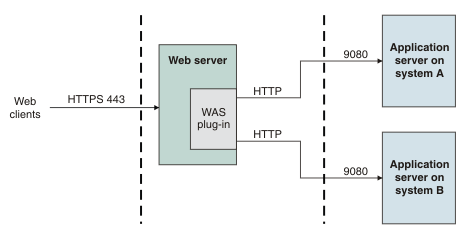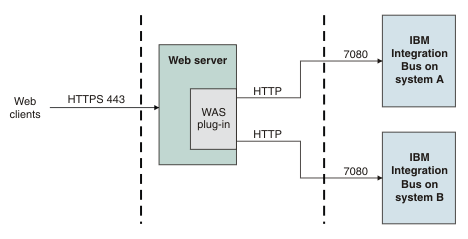Using external web servers with IBM Integration Bus
IBM® Integration Bus is frequently a component in Service Oriented Architecture (SOA) patterns that include external web servers and other HTTP solutions. Learn about the facilities that IBM Integration Bus provides to help you to configure your web server infrastructure, and which configuration option best fits your existing topology.
The following diagram shows a web server topology that uses a web server plug-in generated in WebSphere® Application Server to handle HTTP and HTTPS connections with an application server. The web clients use HTTPS to communicate with the web server, and the WebSphere Application Server plug-in forwards traffic over HTTP to one of two application servers. This topology provides simplified administration: the clients connect to a single endpoint, and all client security is handled in a single place. The plug-in can be used to handle load-balancing and failover between the two application servers.

- Support many HTTP sessions
- Enable access to the integration node from multiple IP addresses and ports
- Simplify the administration of your SOA topology
In the following diagram, IBM Integration Bus takes the place of the application servers. HTTP traffic is handled by integration node listeners on both systems.

The WebSphere Application Server plug-in can be used in the preceding cases, and in more complex scenarios, to:
- Implement load-balancing
- Implement clustering for failover
- Expose application server and web server services and files through a single front end
- Manage security for all URLs in a single place and in a consistent manner
- Set up a network dispatcher to multiple web service endpoints
- If your existing topology incorporates WebSphere Application Server, generate a configuration file that can be read by a WebSphere Application Server web server plug-in
- If your existing topology does not contain WebSphere Application Server, but uses an Apache web server, other than IBM HTTP Server, generate a configuration file that can be merged into your Apache mod_proxy configuration
- If your topology is not described by the previous options, you can use the IBM Integration API to generate a per-integration node list of port and URL data in CSV format, which you can use in your web server configuration
- Generating an HTTP server configuration by using the IBM Integration API
- The documentation on
BrokerProxy.getPortConfigAsCSV()in the IBM Integration API reference documentation